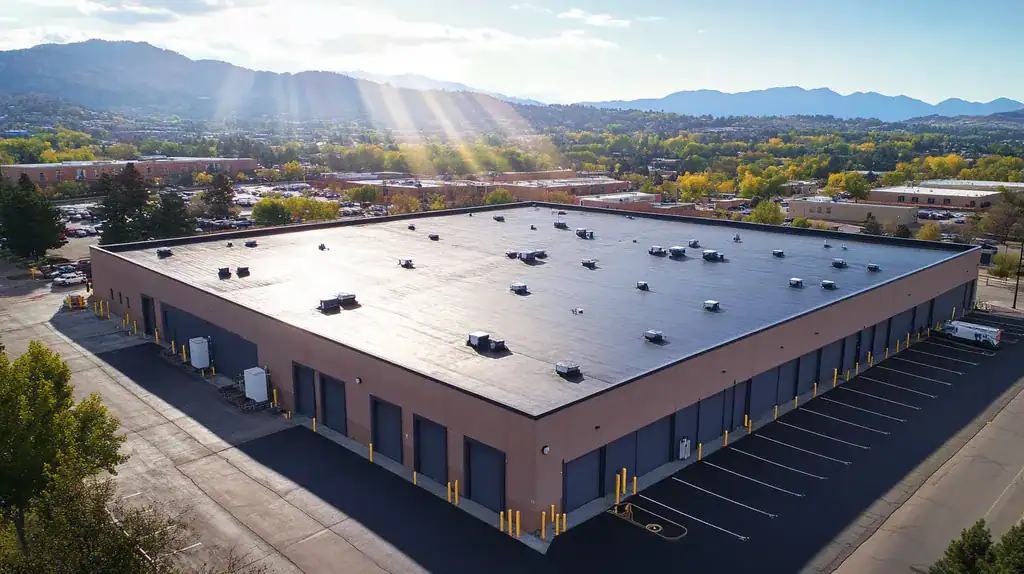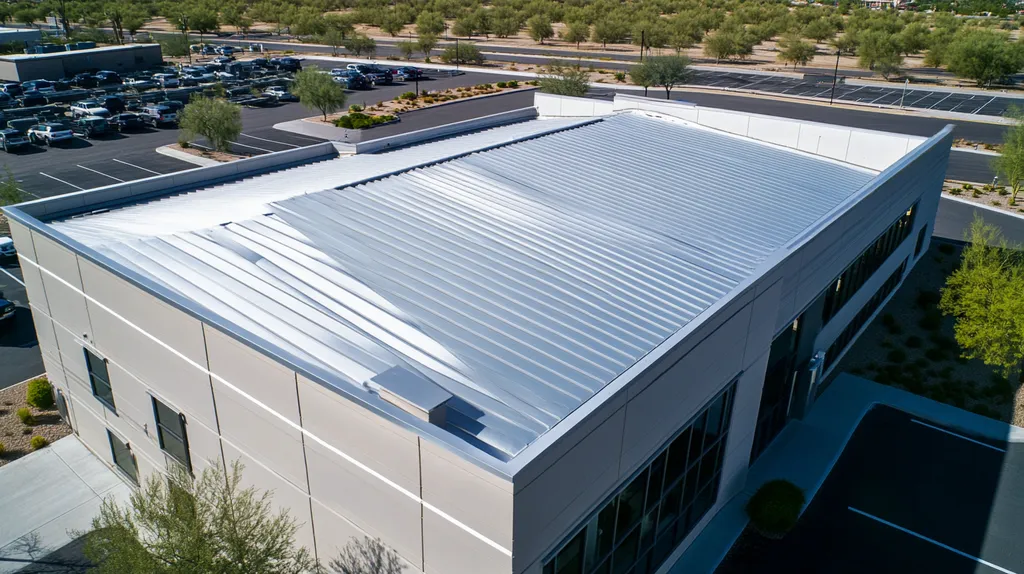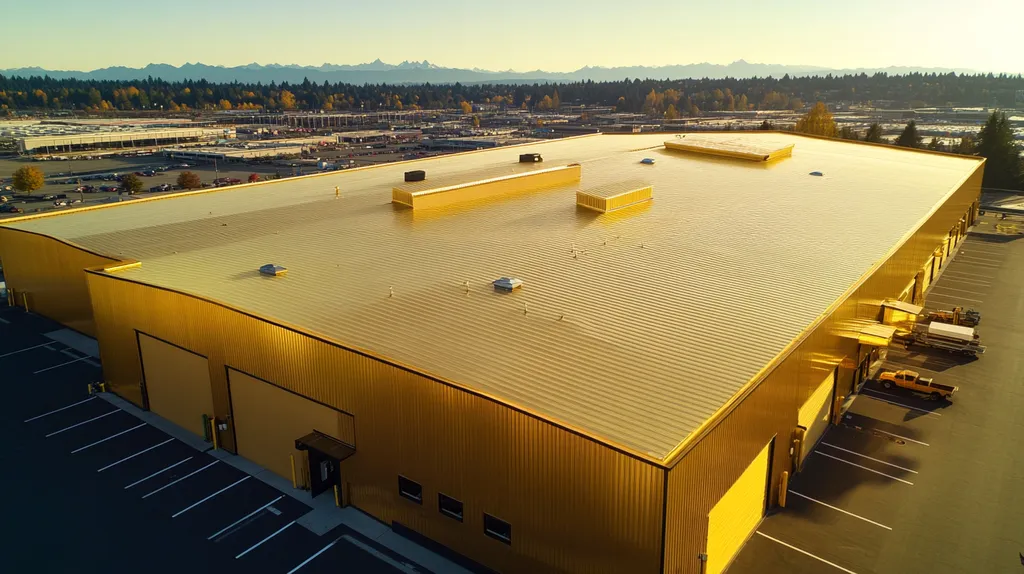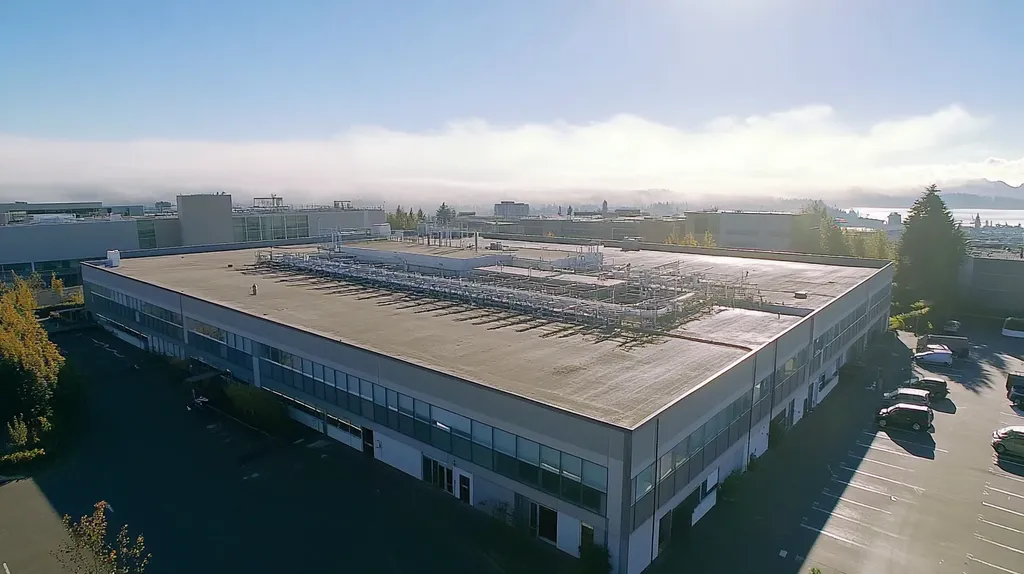In commercial buildings, roof failures cost property owners over $2.5 billion annually in repairs, damaged inventory, and business interruption. Yet studies show that 85% of these catastrophic failures could be prevented through proper maintenance.
For facility managers and building owners, understanding comprehensive roof maintenance isn’t just about protecting an investment – it’s about preventing disasters that can shut down operations and create massive liability exposure.
This definitive guide breaks down the essential components, methods, and strategies needed to maximize commercial roof performance while minimizing lifetime costs through proper maintenance.
SECTION 1: FUNDAMENTAL CONCEPTS
Commercial roofing represents one of the most significant investments in any building’s infrastructure, with replacement costs often exceeding $10 per square foot. Yet many property owners overlook the critical importance of proper maintenance until facing catastrophic failures. Without regular maintenance, even the most expensive roofing systems can fail prematurely, leading to disrupted operations, damaged inventory, and compromised structural integrity.
Understanding Roof Types and Materials
Modern commercial roofing encompasses several distinct categories, each engineered for specific applications and performance requirements. The most common systems include built-up roofing (BUR), modified bitumen, single-ply membranes, and metal roofing.
Built-up roofing systems utilize multiple layers of waterproof materials and bitumen, creating a highly durable surface ideal for buildings with rooftop equipment access. These systems excel in high-traffic environments but require careful maintenance of the protective top coating.
Single-ply membranes, including TPO and EPDM, offer excellent flexibility and UV resistance. These materials have gained popularity due to their ease of installation and energy-efficient reflective properties.
Metal roofing systems provide superior longevity and weather resistance, particularly in regions with extreme temperature variations. Their higher initial cost is often offset by reduced maintenance requirements and extended service life.
Role of Roofing in Building Integrity
Roofs are susceptible to various types of damage, which can compromise building safety if not addressed promptly. An effective commercial roof maintenance plan ensures optimal building performance and early detection of potential hazards. (source: SFS USA)
Beyond weather protection, commercial roofing systems play a crucial role in building energy efficiency. Properly maintained roofs can reduce HVAC loads by up to 15%, directly impacting operational costs.
The roofing system also serves as a critical component in fire safety and structural load distribution. Regular inspections help ensure these vital functions remain uncompromised.
Integration with other building systems, including drainage and ventilation, requires careful attention during maintenance to prevent cascading failures.
Weather Resistance and Durability
Environmental factors significantly impact roofing performance, with UV exposure, thermal cycling, and moisture being primary concerns. Different geographical regions require specific material selections and maintenance approaches.
Regular inspections should focus on areas most vulnerable to weather damage, including membrane seams, flashings, and drainage systems. These components often show early warning signs of weather-related stress.
Proper drainage design and maintenance prevent ponding water, which can accelerate material degradation. Even small amounts of standing water can compromise roofing integrity over time.
Climate change considerations now influence maintenance scheduling, with more frequent inspections needed in regions experiencing increased severe weather events. Adaptation strategies include enhanced reinforcement at vulnerable points and upgraded drainage capacity.
SECTION 2: SYSTEM COMPONENTS
Every commercial roof system comprises essential components that work together to protect valuable assets and ensure building performance. Industry data shows that up to 40% of all roof failures stem from inadequate attention to critical system components. Understanding and maintaining these elements is fundamental to preventing costly failures and extending roof lifespan.
Roof Deck and Insulation Systems
The roof deck forms the foundation of any commercial roofing system, providing structural support and load distribution. Steel, concrete, and wood decking each require specific maintenance approaches to maintain their integrity.
Proper insulation plays a dual role in both energy efficiency and moisture control. When properly maintained, quality insulation can reduce heating and cooling costs by up to 30%.
Regular deck inspections should focus on identifying areas of deterioration, particularly around mechanical equipment mounting points and high-traffic zones. Early detection of deck issues prevents cascading failures that can compromise the entire system.
Insulation damage often manifests through increased energy costs or interior condensation. Property owners should monitor these indicators closely and address any concerns promptly.
Flashing and Penetration Details
Flashing systems protect the most vulnerable areas of commercial roofs, including transitions, terminations, and penetrations. These components require careful attention as they represent the highest risk points for water infiltration.
Professional inspections should examine all flashing conditions, particularly around HVAC units, pipes, and roof edges. Even minor flashing defects can lead to significant interior damage if left unaddressed.
Modern flashing materials offer improved durability and weather resistance, but proper installation remains critical. Updates to existing flashing should always meet current building code requirements and manufacturer specifications.
Maintenance programs must include regular evaluation of sealants and gaskets around penetrations, as these materials naturally degrade over time and require periodic replacement.
Drainage and Ventilation Systems
Effective drainage systems prevent water accumulation that can stress roofing components and lead to premature failure. Regular inspection and cleaning of drains, gutters, and downspouts ensure proper water management.
Proper ventilation balances air movement and helps prevent moisture buildup within the roofing system. Inadequate ventilation can lead to insulation degradation and accelerated membrane aging.
Bi-annual inspections should include thorough evaluation of all drainage components and removal of debris that could impede water flow. Regular maintenance of these systems prevents costly water damage and extends roof longevity. (source: SFS USA)
Property managers should maintain detailed records of drainage system maintenance and any modifications to ensure consistent performance and identify potential problem areas early.
SECTION 3: IMPLEMENTATION METHODS
The difference between a long-lasting commercial roof and premature failure often comes down to implementation quality. Industry data shows that 80% of roof failures stem from poor installation or maintenance practices rather than material defects. For property owners and facility managers, understanding proper implementation methods isn’t just about protecting an investment – it’s about preventing catastrophic failures that can halt operations and create significant liability risks.
Choosing Qualified Roofing Contractors
Contractor selection represents the single most critical decision in commercial roofing implementation. The best materials and designs can fail when installed by unqualified teams, making thorough vetting essential.
Key qualifications include manufacturer certifications, proper insurance coverage, and documented safety protocols. Contractors should provide proof of workers’ compensation insurance and liability coverage specifically for commercial roofing work.
References from similar projects completed within the past three years offer valuable insights into a contractor’s capabilities. Request detailed documentation of past work, including photos and maintenance records.
Local experience matters significantly, as contractors familiar with regional weather patterns and building codes can better anticipate and address potential issues. Verify membership in professional organizations and ongoing training programs.
Ensuring Proper Installation Techniques
Proper installation begins with comprehensive pre-work planning and documentation. Every commercial roofing project requires detailed specifications, material staging plans, and weather contingency protocols.
Quality control measures must include regular inspections during installation, particularly at critical junctures like membrane seaming and flashing installation. Documentation should track environmental conditions, material batch numbers, and installation sequence.
Membrane attachment methods deserve special attention, as improper techniques can void warranties and create long-term problems. Mechanical fastening patterns, adhesive application rates, and seam welding temperatures must meet manufacturer specifications.
An effective quality assurance program includes both visual inspections and instrumental testing. Core samples, pull tests, and infrared scanning help verify proper installation.
Adhering to Industry Standards and Codes
Industry standards provide critical benchmarks for installation quality and safety protocols. Current building codes address wind uplift resistance, fire safety requirements, and energy efficiency standards that vary by region and building type.
ASTM and ANSI standards govern material performance and testing methods. These standards evolve regularly, requiring ongoing education and updates to installation practices.
Documentation of code compliance must be maintained throughout the installation process. This includes permits, inspection reports, and verification of material specifications.
Regular updates to safety protocols ensure compliance with OSHA requirements while protecting workers and property. Fall protection systems, equipment maintenance, and emergency procedures require particular attention.
SECTION 4: MAINTENANCE REQUIREMENTS
Commercial roof maintenance represents a critical investment that directly impacts building longevity and operational costs. Industry statistics reveal that neglected roofs typically last only 10-15 years, while properly maintained systems can exceed 25 years of service. Beyond lifespan extension, proactive maintenance prevents catastrophic failures that can shut down operations, damage inventory, and create significant liability exposure.
Regular Inspection and Diagnosis
Professional roof inspections should occur bi-annually, with additional checks following severe weather events. These evaluations identify developing issues before they escalate into major repairs.
Modern diagnostic tools, including infrared scanning and moisture detection equipment, enable inspectors to locate hidden problems that visual inspection alone might miss. Early detection of subsurface moisture can prevent extensive damage to insulation and decking.
Documentation during inspections must include detailed photographs, measurements, and condition assessments of all roofing components. This creates a historical record that helps track degradation patterns and plan maintenance activities.
Special attention must focus on high-risk areas including penetrations, drainage points, and mechanical equipment mounts. These zones typically show the first signs of deterioration and require more frequent monitoring.
Preventive Maintenance Strategies
An effective commercial roof maintenance plan will ensure optimal building performance and early hazard detection. Regular cleaning of dirt, debris, and vegetation prevents degradation while maintaining proper drainage function.
Scheduled maintenance should include inspection and repair of flashings, seams, and penetrations. These critical components require particular attention as they represent common failure points in roofing systems.
Surface treatments and protective coatings must be maintained according to manufacturer specifications. Proper coating maintenance can extend membrane life while improving energy efficiency.
Clear load limits must be established and enforced to prevent structural damage from equipment placement or maintenance activities. (source: SFS USA)
Addressing Common Roofing Issues
Water infiltration represents the most frequent and damaging roofing issue. Prompt identification and repair of leaks prevents extensive damage to building components and interior finishes.
Surface deterioration, including blistering, splitting, and ridging, requires immediate attention. These conditions indicate underlying problems that will worsen without intervention.
Drainage problems manifest through ponding water and blocked pathways. Regular cleaning and maintenance of gutters, drains, and scuppers ensures proper water removal from the roof surface.
Material fatigue and weathering demand ongoing monitoring and scheduled replacement of aging components. Proactive replacement prevents sudden failures and allows for planned budget allocation.
SECTION 5: PERFORMANCE METRICS
Performance metrics provide the foundation for data-driven decisions in commercial roofing management. Research shows that buildings lacking systematic performance tracking experience 40% higher maintenance costs and twice the rate of catastrophic failures. By implementing comprehensive metrics around condition assessment, energy efficiency, and cost analysis, facility managers can extend roof life while optimizing their maintenance investment.
Assessing Roof Condition and Age
Regular condition assessments establish baseline performance data and track deterioration patterns. Modern inspection protocols combine visual evaluation with advanced diagnostics to create detailed condition profiles.
Key metrics include membrane thickness measurements, seam strength testing, and moisture infiltration mapping. These data points help predict remaining service life and optimize maintenance scheduling.
Digital documentation systems now enable trend analysis across multiple inspections. This historical data helps identify recurring issues and validate maintenance effectiveness.
Preventative maintenance practices following manufacturer guidelines help address potential problems before they escalate into major repairs. Regular checks for leaks, ponding water, and other warning signs are essential for maintaining roof integrity. (source: American WeatherStar)
Measuring Energy Efficiency and Savings
Energy performance metrics directly impact operational costs and sustainability goals. Modern building management systems can track heat flow and thermal efficiency in real-time.
Solar reflectance index (SRI) measurements help quantify cooling efficiency. Higher SRI values indicate better heat reflection and reduced cooling loads.
Thermal imaging surveys identify insulation deficiencies and heat loss patterns. These assessments guide targeted improvements to maximize energy savings.
Cost tracking should include both direct energy savings and indirect benefits like extended HVAC equipment life. Comprehensive analysis often reveals ROI exceeding initial projections.
Evaluating Cost-Benefit Analysis
Financial metrics must consider both immediate costs and long-term value. Life-cycle cost analysis helps justify preventive maintenance investments by demonstrating total ownership savings.
Performance data should track repair frequency, severity, and associated costs. This information enables accurate budget forecasting and maintenance optimization.
Return on investment calculations must include both direct savings and avoided costs. Proper maintenance typically delivers 3-5 times return through extended service life and reduced emergency repairs.
Risk assessment metrics help quantify potential losses from deferred maintenance. These calculations often reveal that prevention costs fraction of potential damage expenses.
SECTION 6: OPTIMIZATION STRATEGIES
Modern commercial roofing demands sophisticated optimization strategies to maximize return on investment while minimizing environmental impact. Industry data shows that optimized roof systems deliver 40% higher energy efficiency and extend functional lifespan by up to 15 years compared to conventional approaches. Yet many property owners continue relying on outdated maintenance practices, missing opportunities for substantial cost savings and performance improvements.
Implementing Sustainable Roofing Solutions
Sustainable roofing solutions represent a critical shift in commercial property management, delivering both environmental benefits and financial returns. Cool roofing technologies can reduce peak cooling demands by up to 15%, translating to significant energy savings in warm climates.
Green roof installations provide multiple benefits beyond energy efficiency, including stormwater management and urban heat island reduction. These systems can retain up to 70% of rainfall, reducing drainage system loads while creating additional usable space.
Recycled and recyclable roofing materials now match or exceed the performance of traditional products while reducing environmental impact. Modern manufacturing processes have eliminated the performance trade-offs once associated with sustainable materials.
Integration of renewable energy systems, particularly solar installations, transforms roof spaces from cost centers into revenue generators. Careful planning ensures these installations enhance rather than compromise roof integrity.
Enhancing Roof Lifespan with Repairs
Strategic repair protocols significantly extend roof service life while preventing cascade failures that can compromise entire systems. Early intervention on minor issues typically costs 90% less than waiting for obvious damage.
Modern repair materials and techniques allow for targeted solutions that address specific failure modes without requiring extensive replacement. Advanced diagnostic tools enable precise identification of problem areas, eliminating guesswork.
Year-round load management represents a critical factor in roof longevity, particularly for structures with rooftop equipment or solar installations. Limiting roof loads and ensuring proper weight distribution prevents structural stress that can accelerate deterioration.
Regular removal of debris and vegetation, combined with proper drainage maintenance, prevents many common causes of premature failure. Keeping gutters and drains clear ensures effective water management during severe weather events. (source: SFS USA)
Integrating Technology for Efficient Maintenance
Digital monitoring systems now provide continuous oversight of roof conditions, alerting managers to developing issues before visible damage occurs. These systems track moisture levels, structural movement, and thermal performance in real-time.
Drone-based inspection protocols reduce risk to maintenance personnel while providing comprehensive documentation of roof conditions. High-resolution imaging and thermal scanning identify potential problems invisible to ground-based inspection.
Predictive maintenance software analyzes performance data to optimize repair scheduling and budget allocation. These systems integrate weather forecasting, material aging curves, and historical performance data to prevent failures.
Building Information Modeling (BIM) integration enables better coordination between roofing systems and other building components. This holistic approach prevents conflicts between different maintenance activities while maximizing efficiency.
The Bottom Line
Commercial roof failures cost U.S. businesses over $2.5 billion annually, yet 85% of these catastrophic events are preventable through proper maintenance.
The difference between a 10-year problem-plagued roof and a 30-year high-performance asset comes down to implementing comprehensive maintenance strategies outlined in this guide.
From regular inspections and preventive repairs to leveraging advanced monitoring technology, facility managers now have more tools than ever to protect their roofing investments.
The stakes are clear: properties that implement systematic maintenance protocols reduce lifetime costs by 60% while virtually eliminating emergency repairs and business interruptions.
In today’s challenging business environment, no organization can afford to neglect this critical infrastructure component that protects millions in assets and operations.
FREQUENTLY ASKED QUESTIONS
Q. Why is maintaining a commercial roof so important?
A. Proper maintenance prevents costly repairs and extends roof lifespan significantly. It ensures early detection of issues, avoiding major disruptions to operations and protecting inventory.
Q. What are essential components of an industrial roof system?
A. Key components include the roof deck, insulation, flashing, and drainage systems. Each element is critical for protecting assets and ensuring effective roof performance.
Q. How can I choose qualified contractors for my commercial roof?
A. Look for contractors with manufacturer certifications, proper insurance, and strong references. Assess their recent project experiences to ensure they are equipped to handle your specific roofing needs.
Q. What are the regular maintenance requirements for commercial roofs?
A. Conduct bi-annual inspections, clean debris regularly, and assess critical components like flashing and drainage to prevent issues. These practices help maintain roof integrity over time.
Q. How can performance metrics improve my roof management?
A. Performance metrics allow tracking of roof condition and operational costs. Analyzing these metrics helps prioritize maintenance and identify early signs of failure.
Q. What optimization strategies can I implement for my commercial roof?
A. Implement sustainable roofing solutions, conduct strategic repairs, and integrate modern technology for monitoring. These strategies enhance efficiency and extend the roof’s functional lifespan.
Q. How often should I inspect my commercial roof?
A. Inspect your roof at least twice a year and after severe weather. Frequent checks enable early identification of potential issues, helping to avoid larger repair costs.










